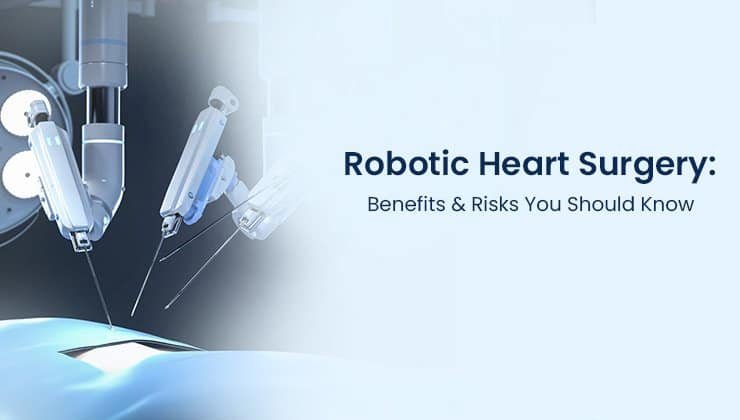Robotic heart surgery has emerged as a pioneering approach in cardiac care, offering patients a less invasive alternative to traditional open-heart surgery. It helps surgeons perform complex procedures using advanced robotic systems with enhanced precision and minimal incisions.
This blog post delves into robotic heart surgery, exploring its benefits, potential risks, and much more!
Understanding Robotic Heart Surgery
Robot-assisted cardiac surgery is a type of heart surgery that involves the use of robotic systems to perform heart surgery through very small incisions in the chest. During the procedure, the surgeons control robot-controlled tools via a console to perform the heart surgery, allowing enhanced dexterity and precision.
It may be conducted to
- Repair or replace leaky heart valves
- Removal of benign growths or tumour in the heart
- Treat congenital heart conditions
- Create a bypass for blocked arteries
- Correct atrial fibrillation.
Types Of Robotic Heart Surgery
The different surgeries that may use robotic systems during the procedure include
- Coronary artery bypass graft to reroute blood past the congested sections of the main arteries.
- Mitral valve repair or replacement to address issues with the mitral valve to restore normal blood flow
- Septal myectomy to treat cardiomyopathy
- Maze procedure for atrial fibrillation therapy
- Congenital heart defect repair to correct structural heart abnormalities present from birth
- Cardiac tumour removal that involves excising a benign tumour from the heart
The choice of treatment depends on the patient’s condition and the type of heart disease.
Benefits of Robotic Heart Surgery
Robotic heart surgery offers several advantages over traditional open-heart surgery, including
- Less invasive: Traditional heart surgery requires the surgeons to cut through the breastbone and open up the rib cage, but robotic heart surgery does not cut through the breastbone. As robotic heart surgery uses small incisions, it reduces trauma to the body.
- Reduced pain and scarring: It makes use of smaller incisions, leading to less postoperative pain, discomfort, and minimal scarring.
- Shorter hospital stay: Patients experience a quicker recovery and shorter hospital stays. On the other hand, traditional surgeries may require a longer hospital stay as they need a longer recovery time.
- Reduced risk of infection: Smaller incisions may decrease the likelihood of postoperative infections and complications.
- Better visualisation: Sometimes, the surgical sites are in a compact space, making it difficult for human hands to perform the surgery. However, the robotic systems provide surgeons with improved visualisation and control, leading to more accurate procedures.
- Advanced precision: Robotic arms require less space and allow for working comfortably in tight spaces. It allows the surgery to be precise.
Risks and Complications of Robotic Heart Surgery
Robotic-assisted cardiac surgery has fewer risks than open-heart surgery. However, like with any other surgery, it carries certain risks, including
- Heart attack
- Stroke
- Bleeding
- Problems linked to using anaesthesia
- Arrhythmias
- Infection
- Death in the worst scenario
The cons of robotic heart surgery include
- Lack of experienced cardiac centres and skilled surgeons performing surgery
- Expensive compared to traditional cardiac surgeries
- Not suitable for all patients
- Longer operating time, especially performed by less experienced surgeons
Patients need to discuss these risks with their healthcare provider to make an informed decision.
Who Is A Good Candidate For Robotic Heart Surgery?
Robotic heart surgery is not suitable for everyone, as every patient is different. You may talk to your healthcare professional to determine if robotic heart surgery is suitable for you.
The healthcare professional performs diagnostic tests, including cardiac catheterisation, chest X-ray, echocardiogram, and CT scan, to determine if you are a candidate for robotic heart surgery.
The different factors that help determine if you are a candidate for robotic heart surgery include
- Medical history and presence of other health conditions that may complicate surgery
- Specific type and severity of the heart condition
- Anatomical considerations, including size, shape, and location of heart structures
Recovery After Robotic Heart Surgery
Recovery after robotic heart surgery is typically faster and less painful than traditional open-heart procedures. Patients may stay in the hospital for 3-5 days.
The recovery times after robotic heart surgery may generally vary, but most people may return to normal activities usually within 2-4 weeks after the surgery.
Patients require regular medical check-ups, follow-up care, and lifestyle changes, including eating healthy and stress management for long-term heart health.
Overall, most patients return to normal activities much sooner than with conventional surgery.
Robotic Heart Surgery Vs. Traditional Surgery
Robotic heart surgery is a minimally invasive procedure that offers greater precision, less postoperative pain, and faster recovery times. Patients may experience shorter hospital stays and smaller scars compared to traditional surgery.
| Aspect | Robotic cardiac surgery | Traditional open-heart surgery |
| Incision size | Small incision size | Large incision size |
| Hospital stay | 2-4 days | 5-7 days |
| Recovery time | 2-4 weeks | Longer period |
| Scarring | Minimal | Higher |
| Risk of infection | Lower | Higher |
| Postoperative pain | Minimal | Higher |
Table: Comparison between robotic heart surgery and traditional surgery
Read Also: Robotic Cardiac Surgery Vs. Open-Heart Surgery: A Comprehensive Guide
Conclusion
Robot-assisted surgeries represent a significant advancement in cardiac care, offering a minimally invasive option with numerous benefits, including smaller incisions, reduced pain, quicker recovery, and lower risk of complications. Understanding the procedure, potential risks, and recovery expectations may help patients make informed decisions about their heart health.
Heart360 Care in Chennai specialises in performing minimally invasive cardiac surgeries under the able guidance of Dr Nikhil and provides the best clinical outcomes to patients with compassion and expertise. If you are exploring the options for heart surgery, schedule a consultation with our specialists to see if robotic cardiac surgery is suitable for you!
Frequently Asked Questions
The robotic cardiac surgery may take about 2-4 hours on average. However, it may vary depending on the type of surgery performed and the patient’s overall health condition. While it may take slightly longer than traditional surgery due to setup and precision steps. The benefits include a shorter hospital stay and faster recovery time.
Robotic heart surgery usually involves very small incisions between the ribs. It results in minimal scarring, unlike traditional open-heart surgery, which leaves a large chest incision or cutting through the breastbone.
Yes, older adults may be a suitable candidate for robotic heart surgery, provided they are relatively healthy and their heart condition may be treated with minimally invasive techniques. However, it is preferable to talk to your healthcare provider to determine if you are suitable for the robotic heart surgery.
Robotic heart surgery is generally considered safe for suitable patients, especially if performed by experienced surgeons. In addition, it offers benefits, including a lower risk of infection, reduced blood loss, shorter hospital stay, and faster recovery. However, it may be suitable for all heart conditions.







